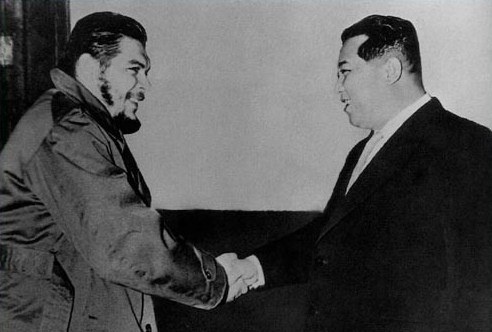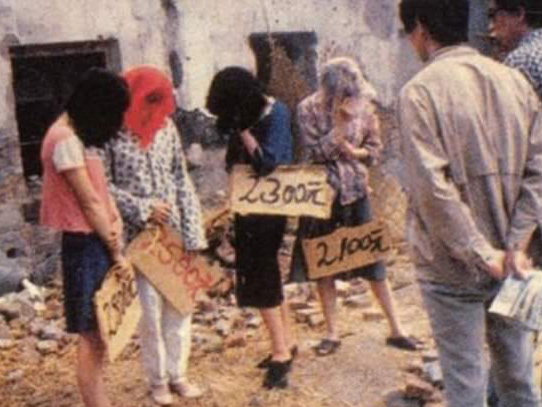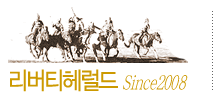|
○ 초기 핵개발(기반 구축)
▪ 북한은 1950년대 中蘇(중소) 협력을 통해 원자력 기반시설 구축
-北蘇(북소)-北中(북중) 원자력협정을 체결하고(1956년, 1959년), 연구용 원자로 도입(1963년)에 이어 영변 지역에 대규모 원자력 단지를 조성(1965년)
-IAEA 가입(1974년) 후 ‘평화적 핵 이용’ 명분 하 5MWe 원자로 착공(1979년)
▪ 1980년대 이후 원자로와 우라늄 정련-변환시설, 핵연료가공공장, 재처리시설을 가동 하는 등 핵개발 본격화
-핵개발의 두 가지 경로인 플루토늄 및 우라늄 농축 프로그램 모두 추진
○ 북한의 핵개발 관련인력 및 핵심부서 현황 (2006년 기준)
▪ 노동당 전병호 비서: 김일성 종합대학 출신으로 군수전문가이며, 현재 핵무기 제 조, 실험배치, 운반, 사용전략 등 핵무기의 개발 관련 총괄 담당. 전병호 1926년 함북 무산출생으로 노동당 정치국 위원, 노동당 비서국 비서, 노동당 군수공업부장, 노동당 군수공업정책검열부장, 국방위원을 역임
-노동당 131 지도국: 핵무기의 제조시점과 설계 및 파괴력에 관한 정보, 핵무기의 배치위치와 관리 및 명령체계에 관한 정보, 인적자원 정보를 총괄 담당하는 기구 -710호: 핵실험 및 고폭실험, 핵무기 개발관련 물적·인적 자금을 총괄적으로 담당하고 핵무기 개발과 관련된 특별기금을 총괄
-원자력 총국 부설 38호 연구소, 11호 연구소 내 핵기술실, 국방대학원 핵 전략연 구실, 제2국방과학원 핵기술실, 평양 101 연구소: 총 5개의 핵관련 연구소들이 존재
-3호광석, 4월 기업소, 8월 기업소: 플루토늄 추출에 이어 우라늄 개발을 위한 연구 소 및 인력
▪ 핵개발 인력 9천여 명 존재: 200명의 핵심 고급인력과 3,000명의 핵개발 전문 인력, 6,000여명의 기술인력 등 총 9,200여명이 존재
-핵개발 전문대학 4곳 존재 :김일성대학, 국방대학, 김책공업대학, 미림대학 존재 그 중 김책공업대학은 핵전기공학과와 핵연료공학과, 원자로공학과를 설치하여 자체적인 인력 양성 대학임
[관련기사] 중국-북한-이란, '미사일-핵(核) 커넥션' 해부
中國(중국)은 모든 核(핵)관련 조약을 무시하고 北韓(북한)과 이란의 核(핵)확산을 돕고 있다.
 金泌材 金泌材
이란은 중국과 북한을 통해 핵기술을 확보했다. 북한은 이란에게서 막대한 자금을 받은 뒤, 이란에 대량파괴무기(WMD) 제조 기술을 제공하고 있다.
일본의 산케이신문 2011년 2월9일자 보도에 따르면 이란이 북한에 제공한 핵개발 자금은 2008년부터 2010년까지 약 20억 달러에 달하는 것으로 알려져 있다.
2008년 3월, 2009년 6월, 2010년 4월 등 3차례에 걸쳐 이란 대표단이 북한을 방문해 핵개발 자금을 지불했다. 구체적으로 이란이 북한에 제공한 자금은 우라늄 농축을 위한 원심분리기의 연구-개발, 기자재 구입, 영변 핵 시설의 방호 태세 강화, 영변 이외의 농축시설 건설 등에 사용됐다. 여기서 생산된 농축 우라늄은 북한 핵개발에 사용됐으며, 해로(海路)를 통해 이란에 운송되고 있다.
북한에게 있어 풍부한 석유자원을 보유한 이란으로부터의 자금 제공은 우라늄 농축 계획 등 핵개발을 진척시키는 데 있어 필수불가결한 요소다.
北(북), 이란에 핵기술인력 200명 넘게 파견
현재 6,000명이 넘는 북한 인력이 이란을 비롯해 중동 각지에 파견되어 있다. 이들의 대다수는 건설 및 보따리 무역을 하는 저임금 노동자들이다. 그러나 이란과 시리아에서 일하는 북한 사람들은 대부분이 기술 인력이다.
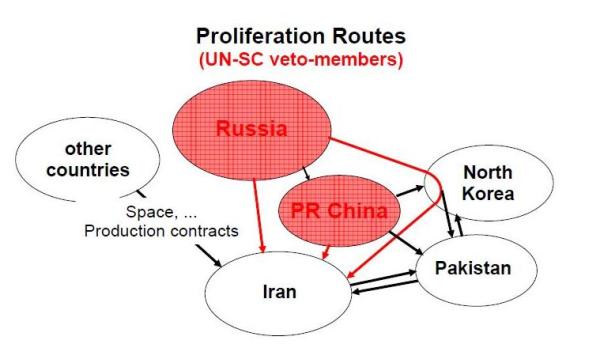 |
| 중국과 러시아를 중심으로 한 불량국가 핵확산 경로. 중국의 배후에는 러시아가 도사리고 있다. |
이스라엘은 2007년 9월 시리아의 핵시설을 공습했다. 그리고 문제의 핵시설에서 북한 과학자들이 시리아의 핵개발을 지원하고 있는 것을 포착했다. 이란에서 활동 중인 북한 인력은 노동당의 직접 지령을 받는다. 이들의 목적은 이란에 노동당의 혁명 이데올로기를 확산시키는 것이다.
이들의 모든 활동은 북한에 있을 때와 마찬가지로 소그룹으로 나뉘어져, 서로가 서로의 일거수일투족(一擧手一投足)을 감시하도록 되어 있다. 이란 파견 북한 인력 가운데 테헤란 주재 북한 대사관의 통제를 받지 않는 사람들이 있다. 이들은 대개 3개 그룹으로 분리되어 있는데 노동당 군수공업부 산하 ‘99호실’ 출신 요원들, 그리고 김정일의 비자금을 관리하는 ‘39호실’ 및 ‘비서실’ 파견 요원들이다.
북한의 WMD수출 담당 위장기업
2002년 이스라엘 정보기관은 북한이 이란에 총 200명이 넘는 핵무기-미사일 제조 관련 기술 인력을 파견한 것으로 파악했다. 이들은 현재 이란의 10여개 비밀 군사 시설에 분산 배치되어 있는 활동 중이다. 아랍에미리트, 카타르, 쿠웨이트 등지에서 일하는 북한 인력은 대개 노동 인력이다. 그러나 이란에서 활동 중인 북한의 고급 인력들은 김정일에게 있어 ‘돈줄’(Cash Cow)라 할 수 있다.
김정일 정권은 중동에서 가장 호전적인 반미(反美)국가인 이란에 핵무기를 확산시킴으로써 이슬람 근본주의에 친북(親北)정서를 주입시키려 하고 있다. 북한의 계획재정부와 비서실은 ‘99호실’과 연계된 위장기업을 통해 이란에 WMD(대량파괴무기) 기술을 수출하고 있다.
이들 조직의 모든 활동은 김정일의 지시 하에 이뤄지고 있다. 노동당의 명령으로 움직이는 제2경제위원회(국방산업 전담조직)는 제2자연과학원을 통해 미사일을 개발하고 있다. ‘99호실’ 명령대로 움직이는 북한의 위장기업들은 이란에 미사일을 수출하고, 이를 통해 획득한 외화는 모두 김정일의 안주머니로 들어간다.
이후 문제의 자금은 또 다시 북한의 핵과 미사일을 개발하는데 사용된다. 2009년 북한 핵실험 당시 UN안보리는 대북결의안 1874를 채택, 북한에 유입되는 외화유입을 차단했다. 아이러니 하게도 UN의 대북제재는 북한에게 있어 이란을 더욱더 중요한 파트너로 만들었다.
결과적으로 북한과 이란의 핵개발 연계 관계가 훨씬 더 공고해졌다. 일본 정보기관이 획득한 북한 노동당 내부 정보에 따르면 WMD 수출을 담당한 북한의 위장 조직은 ‘용각산총무역회사’로 알려져 있다. 위장기업을 통해 무기를 수출하는 방법은 매우 고전적인 수법이다. ‘용각산총무역회사’의 경우 전화번호, 주소 등이 존재하지 않는다.
중국공산당, 북한-이란 핵무기 확산의 배후
한편, 북한과 이란의 WMD 확산의 배후에는 중국 공산당이 숨어있다. 한미일(韓美日) 세 나라는 이제 중국-북한-이란에 대한 적절한 결론을 도출해야 한다. 6자회담은 한국과 일본의 핵무장을 막기 위한 중국과 북한의 협상전략이자 사기극이다.
미국의 헨리 소콜스키 핵비확산정책교육센터 소장은 최근 美(미)월스트리저널(WSJ)과의 인터뷰에서 의도적으로 북한의 핵개발을 돕고 있는 중국을 향해 북핵 문제 해결을 구걸하면 도대체 무슨 의미가 있느냐고 비판하기도 했다.
중국은 핵확산을 금지하는 거의 모든 조약에 가입한 상태다. 그런데도 중국은 모든 핵관련 조약을 무시하고 북한과 이란의 핵확산을 돕고 있다.
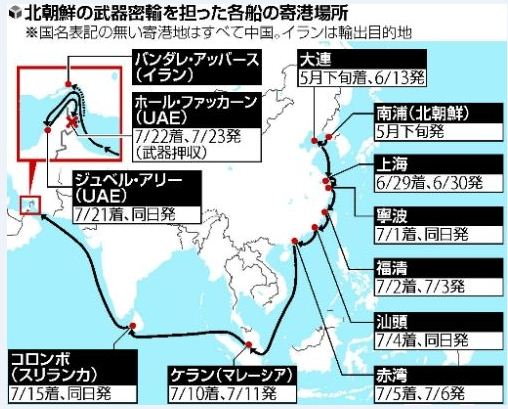 |
|
북한은 중국 공산당의 묵인하에 중국의 항구를 경유해 이란에 WMD를 제공하고 있다.
|
대량파괴무기(WMD)를 수송하는 북한과 이란의 선박/항공기는 아래와 같이 중국의 항구 및 공항(인민해방군 공군기지)을 이용하고 있다.
▲미국 해군은 2002년 12월9일 15기의 스커드 미사일을 싣고 예멘으로 향하는 북한 괴선박 ‘서산호’를 나포했다. 사건 발생 후 스페인 국방부는 ‘서산호’의 마지막 정박지가 중국의 항구였다고 발표했다.
▲2002년 2월과 12월 두 차례에 걸쳐 이란 선박이 중국의 천진항에 정박해 북한의 미사일 부품과 로켓 연료를 적재했다. 당시 한국 정부 관계자는 이란에 수출되는 미사일은 북한산 미사일 본체 및 산화제와 함께 중국이 생산한 유도장치가 결합되어 완성품이 된다고 말했다.
▲중국은 2003년 4월~7월 기간 동안 이란의 일류신(Il-76) 수송기의 중국 영공 통과를 허용, 6번에 걸쳐 이란이 북한을 통해 크루즈 미사일을 실어 나르도록 했다. 당시 부시 행정부는 이란에 영공 통과권을 허용한 중국에 대해 외교적으로 항의했다.
▲2003년 9월11일 美상원외교관계위원회 청문회에서 제임스 켈리 국무부 차관보는 러셀 파인골드 상원의원에게 북한 항공기의 중국 영공 통과 및 재급유 문제를 공개했다.
▲2008년 8월 인도는 미얀마에 착륙한 북한 항공기의 인도 영공 통과를 허용한 사실을 부인했다. 당시 무기를 적재한 북한 항공기의 최종 목적지는 이란이었다. 미국은 이 사건을 통해 중국이 북한 항공기의 화물 내용물이 무엇인지 알면서도 문제 항공기의 자국 영공 통과를 허용해온 사실을 알게 됐다.
▲2009년 8월 중동의 아랍에미리트연합(UAE)은 UN 안보리가 채택한 대북 제재 결의안 1874호 (Resolution 1874)의 이행의 일환으로 북한산 무기를 싣고 이란으로 향하는 화물선 ‘ANL 오스트레일리아’를 검거했다. 당시 문제의 화물은 북한 남포항에서 선적되어 중국 대련항을 거쳐 이란의 반다르 압바스로 향하는 것으로 알려졌다.
▲2009년 12월 북한산 무기를 수송하는 그루지야 국적 IL-76 수송기가 방콕에 재급유를 위해 착륙했다가 미국의 정보를 받은 태국 당국에 검거됐다. 당시 수송기에 실려 있던 북한 무기는 중국에서 선적된 것으로 중국은 이러한 사실을 알고서도 묵인한 것으로 알려졌다.
미국의 ‘전술핵 재배치’ 및 ‘자체 핵무장’ 고려해야
중국의 이 같은 행동은 현상 유지를 위한 것이 아니다. 오히려 세계 안보에 심각한 위협을 초래할 행동으로 현상 타파를 위해 혁명세력이 취하는 전형적인 행동이다. 중국의 이 같은 행태를 경계해야 한다. 진정한 ‘악의 축’은 북한과 이란의 배후에 숨어 있는 중국 공산당이다.
북한은 현재 야포와 미사일에도 쉽게 장착-사용 할 수 있는 소형의 핵무기를 개발 중인 것으로 알려져 있다. 가까운 장래에 사단-군단급도 아닌 대대-연대단위의 부대에서도 유사시 핵무기를 사용할 수 있게 된다는 뜻이다.
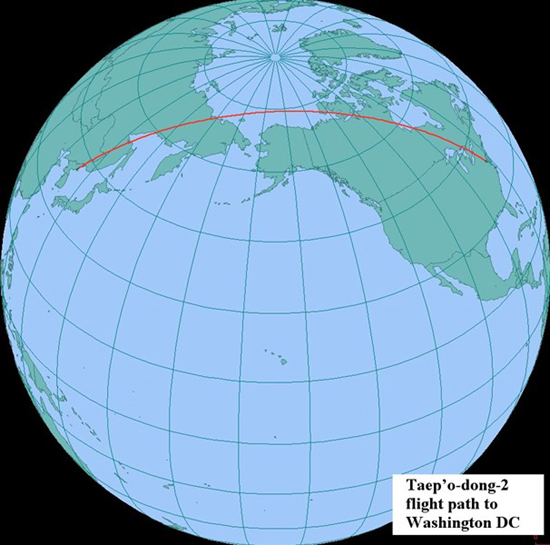 |
| 대포동-2호는 탄도 중량을 500kg이하로 줄일 경우 미국의 수도 워싱턴 D.C.까지 도달이 가능하다. |
김정일은 언론에서 종종 ‘무모한 미치광이’로 묘사되어 왔다. 그러나 김정일은 핵개발 분야에 있어서만큼은 ‘이성적인 과정’을 추구해왔다고 여겨진다. 북한은 가까운 장래에 엄청난 양의 핵탄두를 보유하게 될 것이다. 북한의 핵무기는 대한민국의 미래에 사활이 걸린 치명적이고 불안정한 위협이다.
이러한 위협에 대처하기 위해서는 미국과 일본 등 우방국 간의 보다 적극적인 군사협력 체제의 구축이 필요하다. 여기서 북한의 3대 세습이 성공할 것이냐 실패할 것이냐를 두고 ‘갑론을박’(甲論乙駁)을 하는 것은 시간낭비일 뿐이다.
북한의 핵전략은 중국 핵전략에 종속되어 있다. 지금은 대한민국 생존을 위해 미국의 ‘전술핵 재배치’ 및 ‘자체 핵무장’을 깊게 고려해야 할 때다.(2011.10.04/조갑제닷컴)
김필재(조갑제닷컴)/spooner1@hanmail.net
The Cuban Missile Crisis and the Origins of North Korea’s Policy of Self-Reliance in National Defense
Introduction by James F. Person
The trajectory of North Korea’s foreign relations and economic and military planning dramatically shifted in the early 1960s in response to two events. The first was a May 1961 coup d’état in South Korea that brought to power an anti-communist military junta led by General Park Chung Hee. The second event occurred much further from Korea’s borders—thousands of miles away on an island nation in the Caribbean. Combined, the Park Chung Hee coup d’état and the Cuban Missile Crisis transformed North Korea’s relations with Moscow and Beijing and nudged the country down a path of unsustainable military buildup that, in part, resulted in a nuclear weapons program and was responsible for the country’s economic difficulties in later decades.
North Korean leaders greeted the 1960s with optimism. The country continued its phoenix-like rise from the ashes of the devastating Korean War (1950-1953) by successfully completing, ahead of schedule, a Three-Year Plan for national reconstruction and a Five-Year Plan for comprehensive industrialization. Premier Kim Il Sung had also survived the most serious political challenge of his long tenure in 1956.[1] The toll of the social change at breakneck speeds that accompanied North Korea’s post-war economic and political developments had not gone entirely unnoticed, and the leadership of the country had designated 1960 as a “buffer year” during which the pace of development would be slowed down before launching into an ambitious Seven-Year Plan. [2] Conditions on the divided peninsula also appeared more favorable to North Korea. In April 1960, South Korean president Syngman Rhee was forced from office following a series of massive student led demonstrations. The North Korean leadership identified in this an opportunity for unification, and proposed the establishment of a Korean Confederation that would allow for both regimes to temporarily maintain their social systems as they transitioned to a unified system of government. [3]
All of this changed on 16 May 1961 when Park Chung Hee led a coup against the democratically elected government of President Yun Po Sun and Prime Minister Chang Myong, who had been in power for less than a year after President Syngman Rhee was forced from office. Although there was some initial confusion about Park’s political orientation, given a brief dalliance with communism, North Korea soon determined that the coup leader was in fact anti-communist. On 18 May, the Standing Committee of the ruling Korean Worker’s Party called for measures to be taken to drastically militarize the state. According to Chinese reports of the meeting, the Standing Committee decided to “enhance our vigilance, concentrate forces on strengthening national defense, and delay the original Seven-Year Plan until 1963. Otherwise economic construction and the national defense industry would be held up.” [4] North Korea began to take such measures without delay. A month after the coup, on 19 June, a North Korean diplomat in Budapest reported to the Hungarian Foreign Ministry that Pyongyang had issued an order for the army to enhance vigilance and reduce the number of workers in industry and reassign them to the national defense industry and defensive fortifications to prepare for an emergency situation.[5]
Within two months of the South Korean military coup, North Korea signed a Treaty of Friendship, Cooperation and Mutual Assistance with the Soviet Union. Within days, Pyongyang signed a similar agreement with Beijing. With the inclusion of mutual defense clauses that committed both parties to aid one another if attacked, both agreements provided North Korea with a greater sense of security.
Yet, the road to getting this agreement with the Soviet Union in particular was long and not without its challenges. The treaty with Moscow therefore did not instill in Kim Il Sung a sense of confidence in Moscow’s security commitment to the DPRK. In fact, Kim had been trying to get such an agreement from the Soviets for over two years. A few months after the withdrawal in October 1958 of the Chinese People’s Volunteer Army (which had entered North Korea in late 1950 to fight the Americans), Kim Il Sung traveled to Moscow in late January 1959 to attend the CPSU XXI Congress. During this trip, Kim proposed the signing of a mutual cooperation treaty with the Soviet Union, Pyongyang’s chief supplier of advanced weaponry and machinery. Though Khrushchev acceded to his request, and agreed to visit Pyongyang later that year to sign the agreement, for over two years, the Kremlin leader found reasons to postpone his trip. Khrushchev finally signed the agreement in July 1961 when Kim traveled to Moscow.
The North Korean leadership believed that their suspicions of Moscow’s unreliability were confirmed in October 1962 when Khrushchev “betrayed Cuba at the time of the Caribbean crisis.” [6] What the North Koreans viewed as Soviet capitulation in the face of pressure from the Kennedy Administration demonstrated that Khrushchev was more concerned about peaceful coexistence, and being, in the words of Kim Il Sung, “buddy-buddy with Eisenhower and
Kennedy” than he was in aiding smaller socialist countries that, in the eyes of the North Koreans, were vulnerable to being picked off, one by one, by the United States. [7] During a tense exchange in January 1965, North Korean Vice Premier Kim Il explained to Soviet Premier Aleksei Kosygin that as a result of the Cuban Missile Crisis, the North Korean leadership felt that it “could not count that the Soviet government would keep the obligations related to the defense of Korea it assumed in the Treaty of Friendship, Cooperation and Mutual Assistance.” [8]
This mistrust of Moscow was reinforced when the Soviets did not grant a request from Pyongyang for military aid in December 1962. In the immediate wake of the Cuban Missile Crisis, on 1 November Kim Il Sung expressed his concern to Soviet Ambassador Vasily Moskovsky that the North’s air and coastal defenses were in poor shape. Major cities, such as Pyongyang, Wonsan, Chongjin, and Hamheung, were poorly protected from air raids. He therefore requested permission to send a delegation to Moscow to discuss military aid [9] Kim requested that the Soviet Union deliver—on credit—over 100 million rubles in military aid to North Korea. Specifically, to enhance coastal defenses, he asked for submarines. For air defenses, Kim requested an unspecified number of MIG-21s and twelve surface-to-air missile batteries.[10] In a 14 November conversation with Ambassador Moskovsky, Kim Il Sung played up the threat to North Korea, remarking “I know that [First Secretary Khrushchev and Second Secretary Frol Kozlov] are no less concerned than I about the defense of the Far Eastern forward post…it provides a convenient platform for the enemy’s landing.”[11] Yet, Deputy Premier Kim Gwanghyeop’s 29 November to 5 December visit to Moscow ended in failure. Moscow would sell the weapons to Pyongyang, but not give them on credit. [12] Without delay, the North Korea regime escalated its efforts to achieve self-reliance in national defense. One week later, the Fifth Plenum of the Fourth KWP Central Committee formally adopted what it referred to as the equal emphasis policy, initially launched in the wake of the May 1961 military coup in South Korea, which called for simultaneous development of heavy industry and defense capabilities. The Plenum also declared Four Military Guidelines: to arm the entire population to fortify the entire country to train the entire army as a “cadre army” and to modernize weaponry, doctrine, and tactics under the principle of self-reliance in national defense. Hungarian diplomats reported that by February 1963 “large-scale work [was] going on throughout the country not only entrenchments but also air-raid shelters for the population [were] being built in the mountains.” [13]
This policy of keeping the country in a state of mobilization had drastic effects on the North Korean economy. As Vice Premier Kim Il would later describe, because of the lessons of the Cuban Missile Crisis, North Korea was “compelled to keep an army of 700,000 and a police force of 200,000. These huge armed forces constituted enormous expenses for the national economy of the DPRK, and this is why neither industry nor agriculture had made headway.”[14] Kim Il Sung elaborated on the tremendous economic cost to Kosygin:
We had to look for financing exclusively within our own country, and we could get it only at the expense of other sectors. I am sure I don’t have to tell you how large amounts of money it involved. That is why we are currently falling behind in completing the 7-year plan by one year, and we still need 3 to 5 years in order to fulfill the seven year plan at least in basic parameters. However, 4 years and 2 months have passed and we have fulfilled less than half of the 7-year plan’s goals.[15]
The Cuban Missile Crisis also led to a major shift in North Korea’s foreign policy orientation. Despite long-standing disagreements between Moscow and Pyongyang over North Korea’s autarkic development strategy, relations remained cordial through 1962. In the wake of the Cuban Missile Crisis, however, North Korea publicly sided with the Chinese in the Sino-Soviet split, and expressed opposition to Khrushchev’s purported revisionism, particularly his policy of peaceful coexistence with the United States. Both Pyongyang and Beijing advocated for a far more militant policy of anti-imperialist struggle.
The Soviet-North Korean rift lasted from the fall of 1962 through the end of 1964. During this period, North Korea drew closer to the People’s Republic of China than at any point in the history of Sino-DPRK relations. The fear of losing their freedom of action due to long term exclusive orientation toward the PRC eventually forced North Korean leaders to change their approach to developing international contacts with the USSR and European socialist countries. This change coincided with Khrushchev’s involuntary departure, in October 1964, from the leadership of the CPSU and USSR. In January 1965, North Korean Vice Premier Kim Il went to Moscow where he met with Kosygin. The two held very frank talks in which Kim Il revealed North Korea’s thinking on the Cuban Missile Crisis and the actions Pyongyang was forced to take in light of the perceived betrayal to the smaller countries in the socialist camp. Kim accused the Soviets of having betrayed the Cubans, and two years later the (North) Vietnamese by not responding fittingly to the August 1964 Gulf of Tonkin incident.[16]
The next month, in February 1965, while returning from a trip to Hanoi and then Beijing, Kosygin visited the DPRK where he met twice with Kim Il Sung. The North Korean leader echoed many of comments which Kim Il had made in Moscow the previous month. Kosygin defended Moscow’s response to the 1962 Cuban Missile Crisis and, turning Pyongyang’s own rhetoric on Kim, admonished the North Korean leader for not doing enough in the anti-imperialist struggle.[17] The Soviet Union, Kosygin argued, was in fact fighting imperialism. During their second conversation, Kim elaborated on the tremendous economic difficulties the DPRK faced as a result of measures to strengthen national defense that were adopted in December 1962 because of the perceived unwillingness of Moscow to live up to its security commitments to Pyongyang. The February 1965 Kosygin visit became an important catalyst of the favorable change in Pyongyang’s attitude toward the Moscow.
While the shift in North Korea’s foreign relations after the Cuban Missile Crisis was short-term and relations with Moscow once again improved, Pyongyang never abandoned its belief in bellicose anti-imperialism. Later in the 1960s, for a period of about three years, North Korea began to launch cross-border raids and engaged in other provocative acts against South Korea at a rate of nearly one a day [18] Other impacts of the Cuban Missile Crisis on North Korea were not so temporary. A careful reading of the available documentary evidence from the archives of Pyongyang’s former communist allies suggests that Kim Il Sung never fully trusted the Soviets again. Moreover, the country remained in an uninterrupted state of mobilization for decades and escalated efforts to achieve self-reliance in national defense, particularly through the acquisition of a nuclear deterrent. This contributed in part to North Korea’s eventual economic slowdown.
James F. Person is the Senior Program Associate for the History and Public Policy Program and coordinator of the North Korea International Documentation Project at the Woodrow Wilson International Center for Scholars. He is currently completing a PhD in Korean history at the George Washington University, working on a dissertation on North Korea's relations with the Soviet Union and China from 1956-1967.
[1] See James F. Person, “New Evidence on North Korea in 1956,” CWIHP Bulletin 16 (Spring 2008): 447-454.
[2] See, for example, Balazs Szalontai, Kim Il Sung in the Khrushchev Era: Soviet-DPRK Relations and the Roots of North Korean Despotism, 1953-1964 (Washington, DC: Woodrow Wilson Center Press Stanford, CA: Stanford University Press, 2006), 138.
[3] See “New East German and Soviet Evidence on North Korean Support to South Korean Political Parties and Labor Unions,” NKIDP eDossier no. 8 (June 2012).
[4] “Contents of the 18 [May] [North] Korean Party Central [Committee] Standing Committee Meeting,” 21 May 1961, Chinese Foreign Ministry Archive, File No. 106-00581-06.
[5] Hungarian Foreign Ministry, Memorandum, 22 June 1961, “Visit of Comrade Paek Chong-won.” XIX-J-1-j Korea (Top Secret Documents), 1945-64, 3, doboz, 4/af, 003159/7/1961.
[6] Embassy of Hungary in North Korea to the Hungarian Foreign Ministry, 8 January 1965, MOL, XIX-J-1-j Korea, 1965, 73. doboz, IV-100, 001819/1965, Report
[7] Record of a conversation with the Soviet Ambassador in the DPRK Comrade V.P. Moskovsky about the negotiations between the Soviet delegation, led by the USSR Council of Ministers Chairman Kosygin, and the governing body of the Korean Workers Party, 16 February 1965, Czech Foreign Ministry Archive.
[9] Memorandum of Conversation between Soviet Ambassador to North Korea Vasily Moskovsky and Kim Il Sung, 1 November 1962, AVPRF, Fond 0102, Opis 18, Papka 93, Delo 5, Listy 135-138.
[10] Memorandum of Conversation between Soviet Ambassador to North Korea Vasily Moskovsky and Kim Il Sung, 14 November 1962, AVPRF, Fond 0102, Opis 18, Papka 93, Delo 5, Listy 152-154.
[12] See, for example, Szalontai, Kim Il Sung in the Khrushchev Era, 192.
[13] Report, Embassy of Hungary in North Korea to the Hungarian Foreign Ministry, 15 February 1963, XIX-J-1-j Korea, 6. Doboz, 5/d, 0011/RT/1963.
[14] Report, Embassy of Hungary in North Korea to the Hungarian Foreign Ministry, 8 January 1965, MOL, XIX-J-1-j Korea, 1965, 73. doboz, IV-100, 001819/1965.
[15] Czech Foreign Ministry Archive, Record of a conversation with the Soviet Ambassador in the DPRK Comrade V.P. Moskovsky about the negotiations between the Soviet delegation, led by the USSR Council of Ministers Chairman Kosygin, and the governing body of the Korean Workers Party, which took place at the USSR Embassy in the DPRK on 16 February 1965.
[16] Report, Embassy of Hungary in North Korea to the Hungarian Foreign Ministry, 8 January 1965, MOL, XIX-J-1-j Korea, 1965, 73. doboz, IV-100, 001819/1965.
[17] Conversation with the Soviet Ambassador, 19 February 1965, Hungarian National Archives.
[18] See Christian F. Ostermann and James F. Person, eds., Crisis and Confrontation on the Korean Peninsula, 1968-1969: A Critical Oral History (Washington, DC: Woodrow Wilson International Center for Scholars, 2011).
|
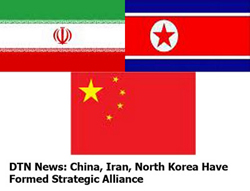















 金泌材
金泌材 